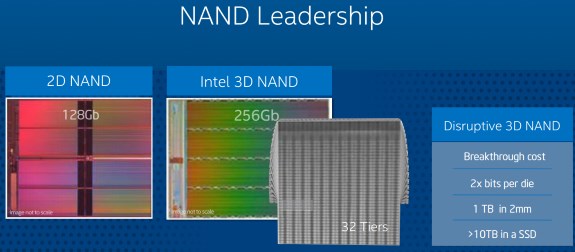
The 3D NAND flash memory promises a breakthough in terms of cost and will result in compact mobile SSDs with a 1TB capacity and a thickness of merely 2mm. A couple of years from now, 3D NAND is expected to result in solid state disks with a capacity of 10TB.
For comparison, Samsung's 32-layer V-NAND flash memory delivers just 86Gb per MLC die and 128Gb in a TLC config, giving Intel and Micron a substantial lead in storage density. Samsung's next-generation V-NAND should be ready in the second half of 2015 though and we know little about that flash's density, so it's too early to judge.
The 3D NAND's planar layers are built with a coarser fabrication process than the latest and greatest 2D flash. Those layers are pierced by four billion "pillars" that run vertically through the die, but Intel isn't ready to disclose specifics about the underlying process geometry.
Crooke effectively demoed working silicon by running his presentation off a prototype drive. Intel hasn't decided which market segment will get the first taste, though. Datacenters, corporate clients, and PC enthusiasts top the list.

Source: The Tech Report